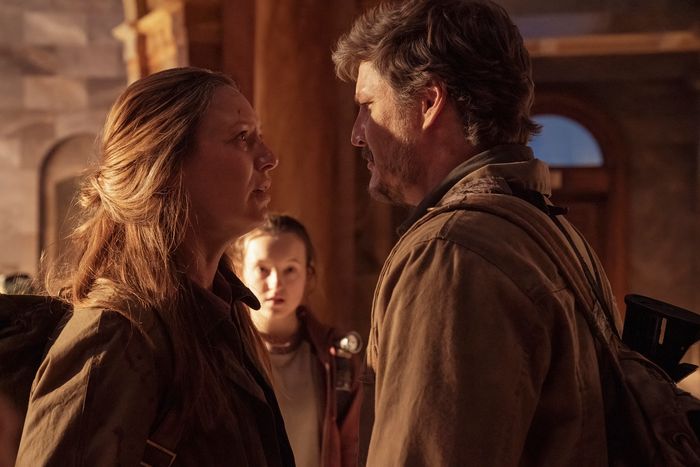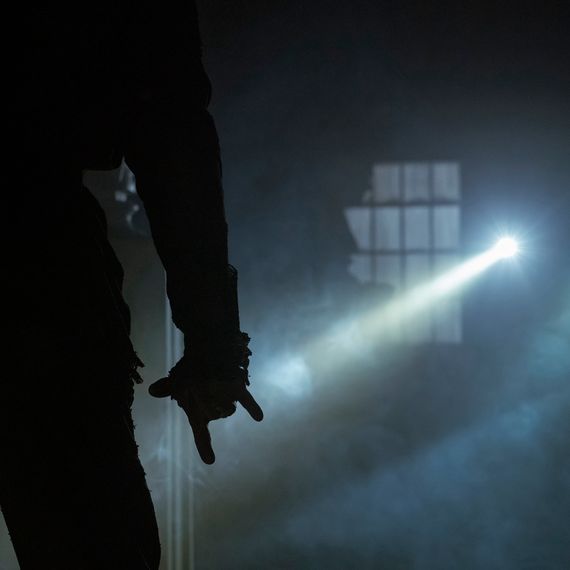
Spoilers follow for the second episode of The Last of Us, “Infected,” which premiered on HBO on January 22, 2023.
All horror subgenres, and the monsters who populate them, have a certain set of tropes that communicate to viewers what they can expect from that type of story. Haunted houses and their spooky noises can signal familial dysfunction; werewolves and the full moon, the allure of reckless unrestraint; and zombies — with their lurching gait and askew limbs, single-minded obsessiveness, and that chomping hunger — the danger of conformity.
The Cordyceps-controlled in The Last of Us aren’t undead like the zombies of George A. Romero’s definitive films or the sprawling franchise world of The Walking Dead, or infected with the Rage Virus, as in 28 Days Later and 28 Weeks Later. And The Last of Us co-creators Craig Mazin and Neil Druckmann have pushed back against the Z-word by emphasizing how the Cordyceps plague is based in trackable science. But even as the series’ first two episodes take great care to differentiate, through various biological inventions, what we’re watching now from what we’ve watched before, the tension and heartache of the season’s introductory arc is directly indebted to the zombie subgenre’s familiar filmmaking flourishes: a shriek in the distance, and a guttural growl close by; a single figure spotted down a dark hallway, and a crowd of bodies moving in unison, converging in a dense swarm; a gaping mouth full of bloody teeth, threatening to bite — and in The Last of Us, gossamer-like fungal threads, ready to unfurl and infect.
Tess is also bitten and dies defending Joel and Ellie in the video game, but the circumstances of her death in “Infected” are unique to TV’s The Last of Us, thanks to the invention of an underground Cordyceps network that can activate infected people in other locations. And onscreen, her sacrifice is all the more meaningful for how it honors both the genre’s historical interest in the cost of individual choice, and The Last of Us’s specific interest in the galvanizing effect of hope. Tess’s last stand is a tearjerker, and her beseeching Joel to “set everything right, all the shit we did” — a new line written by Mazin for this episode — complements The Last of Us’s morally minded tableau.
Those going into The Last of Us with no awareness of the video game’s plot might have expected Anna Torv’s character to last longer than two of season one’s nine episodes; I certainly did. While the first half of premiere episode “When You’re Lost in the Darkness” centered on Joel and his brother Tommy and suggested that their blue-collar, combat-zone backgrounds made them preternaturally adept at fighting the Cordyceps-controlled, the second half introduced Tess as a resourceful woman and fellow smuggler equal in ability. Torv’s sweet spot as an actress, evidenced by her work on Fringe and the canceled-too-soon Mindhunter, is as an incisive and intuitive pragmatist who can size up a situation and get a read on a person more quickly than anyone else, and she brings those qualities — her even gaze, her assured body language — to Tess. She’s a steady partner to Joel, and the comfortable, familiar way in which they speak to each other suggests a long relationship after the death of his daughter Sarah at the beginning of the outbreak.
When Joel and Tess agree to transport the mysteriously valuable Ellie outside the Boston QZ and to a stronghold of insurgent Fireflies so they can take her west, it’s Tess whom Ellie warms up to first, and whom she looks to for guidance and protection as The Last of Us cycles through a number of familiar zombie scenarios: a history lesson, with Tess explaining to Ellie as they look into a gigantic crater in a street outside Boston’s QZ that bombing to contain Cordyceps “worked here, but it didn’t in most places.” A silence-penetrating scream they hear while making their way through car-jammed roads, and a camera pan that reveals nothing in their immediate vicinity; a look over a hotel’s balcony at a field of infected feasting on humans, and a long take that reveals them moving in unison away from the sunlight and toward shadow. A crash course in how these particular infected work, during which Tess explains to Ellie (and us) that Cordyceps also grows underground, with long fibers that connect patches of fungus — and the former humans attached to them — into an aware organism that spans up to a mile. And an agonizing climb up a body-filled stairway into an exit-blocked room, where Tess tries to protect Ellie from the pair of Clickers using echolocation and the camera tiptoes around blind corners, finds reflections in chunks of jagged glass, and swings upward to greet infected sprinting straight at us.
What comes next, after the trio have escaped the Clicker-filled museum and made it to the statehouse full of dead Fireflies, is also a zombie hallmark: Tess revealing to Ellie and Joel a previously hidden bite on her neck, its proximity to her brain meaning that in mere minutes, she’s already beginning to turn. This moment exists in the video game, too, with Tess uttering the same resigned “Our luck had to run out sooner or later” line and pushing Joel and Ellie away from her so they can escape the FEDRA soldiers advancing upon them.
But the changes that Mazin and Druckmann make to this moment for the TV show give it grander existential stakes and a more nauseating sense of how Cordyceps infiltrates and ingratiates. Torv gives Tess’s expanded dialogue a mixture of steeliness, solemnity, and melancholy as she speaks to her and Joel’s shared past, and to the opportunity Ellie presents for a better future. (“Joel, she’s fucking real … This is your chance to get her there, to keep her alive.”) Her assured physicality as she knocks over gallons of gasoline, empties a box of hand grenades, and flicks a lighter over and over to get it to spark as the Cordyceps-infected stream into the statehouse conveys her resilience and commitment. And there is an incredibly human quality to the changed dynamics here, with Tess standing against the turned instead of against FEDRA.
Tess being killed by FEDRA is a political statement on the evil of a police state, but given how Joel’s daughter Sarah is killed in the beginning of the game and TV series, it almost feels like a repetitive point. Tess attacking the Cordyceps collective, meanwhile, is her final act of singularity. Her choice to die as she wants, instead of becoming yet another component of the identity-less infected, is an expression of free will against an entity that defies humanity’s understanding of natural law, a last investment in the kind of optimism that she and Joel have spent years refusing, and an act of resistance that will have lingering effects on the story to come.
Watching a monstrous transformation, or walking through a yawning doorway into a menacing room, or standing behind a twitching foe as it moves toward our protagonists — the immediately prickly and panicked reactions we have to these compositions and perspectives in The Last of Us are informed by decades of similar images throughout film and TV. And while Mazin and Druckmann may discourage zombie comparisons, the noble and tragic send-off they give to Tess in “Infected,” via a deadly kiss that brings to mind 28 Weeks Later pushed into more grotesque territory, is a reminder that no genre trope stays dead for long.



